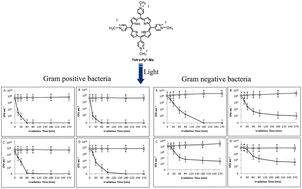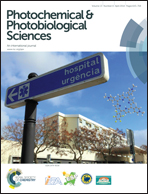Influence of external bacterial structures on the efficiency of photodynamic inactivation by a cationic porphyrin
Abstract
The main targets of photodynamic inactivation (PDI) are the external bacterial structures, cytoplasmic membrane and cell wall. In this work it was evaluated how the external bacterial structures influence the PDI efficiency. To reach this objective 8 bacteria with distinct external structures were selected; 4 Gram-negative bacteria (Escherichia coli, with typical Gram-negative external structures; Aeromonas salmonicida, Aeromonas hydrophila both with an S-layer and Rhodopirellula sp., with a peptidoglycan-less proteinaceous cell wall and with cytoplasm compartmentalization) and 4 Gram-positive bacteria (Staphylococcus aureus, with typical Gram-positive external structures; Truepera radiovictrix, Deinococcus geothermalis and Deinococcus radiodurans, all with thick cell walls that give them Gram-positive stains, but including a second complex multi-layered membrane and structurally analogous to that of Gram-negative bacteria). The studies were performed in the presence of 5,10,15,20-tetrakis(1-methylpyridinium-4-yl)porphyrin tetraiodide (Tetra-Py+-Me) at 5.0 μM with white light (40 W m−2). The susceptibility of each bacteria to PDI by Tetra-Py+-Me was dependent on bacteria external structures. Although all Gram-positive bacteria were inactivated to the detection limit (reduction of ∼8 log) after 60–180 min of irradiation, the inactivation followed distinct patterns. Among the Gram-negative bacteria, E. coli was the only species to be inactivated to the detection limit (∼8 log after 180 min). The efficiency of inactivation of the two species of Aeromonas was similar (reduction of ∼5–6 log after 270 min). Rhodopirellula was less susceptible (reduction of ∼4 log after 270 min). As previously observed, the Gram-positive bacteria are more easily inactivated than Gram-negative strains, and this is even true for T. radiovictrix, D. geothermalis and D. radiodurans, which have a complex multi-layered cell wall. The results support the theory that the outer cell structures are major bacterial targets for PDI. Moreover, the chemical composition of the external structures has a stronger effect on PDI efficiency than complexity and the number of layers of the external coating, and lipids seem to be an important target of PDI.


 Please wait while we load your content...
Please wait while we load your content...